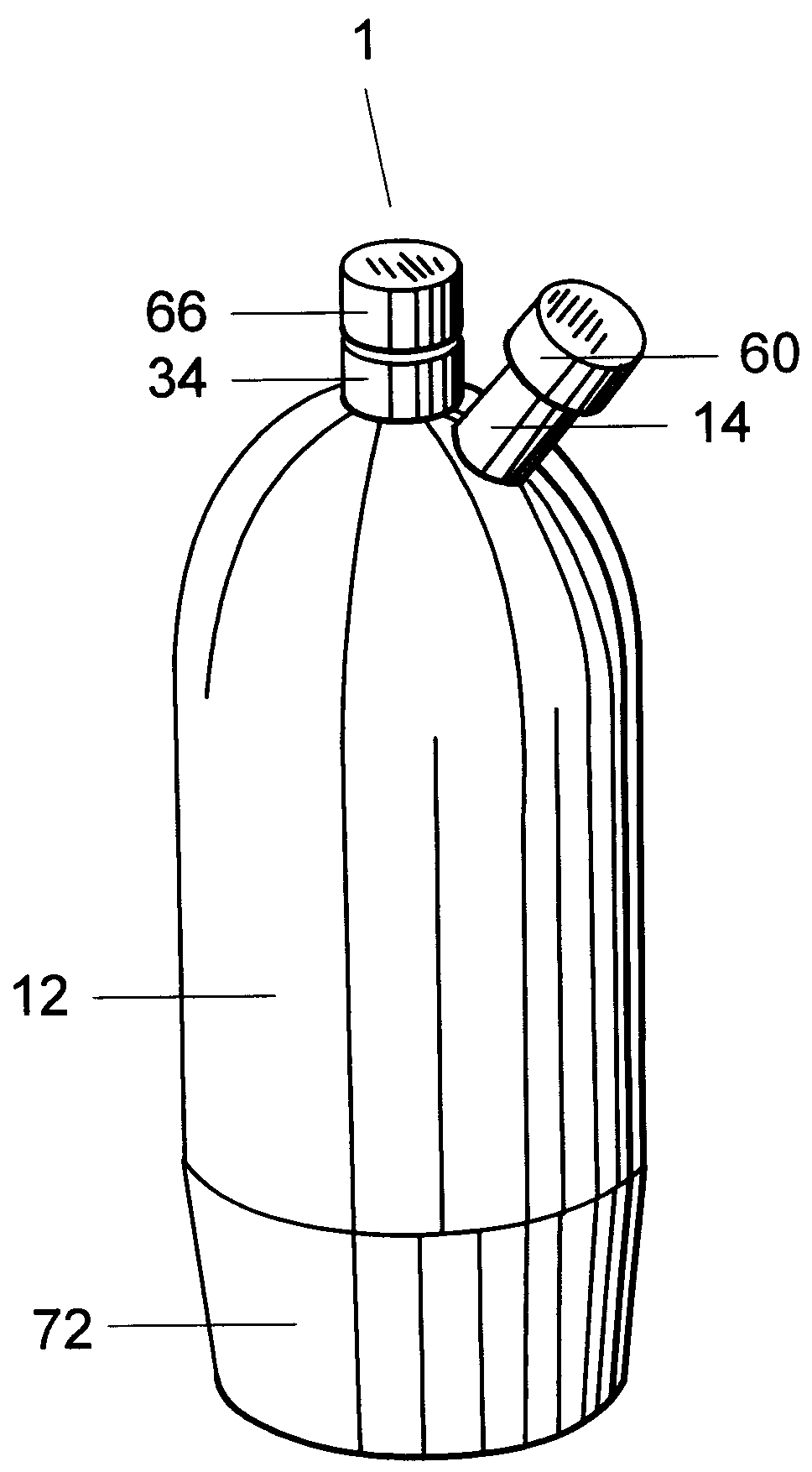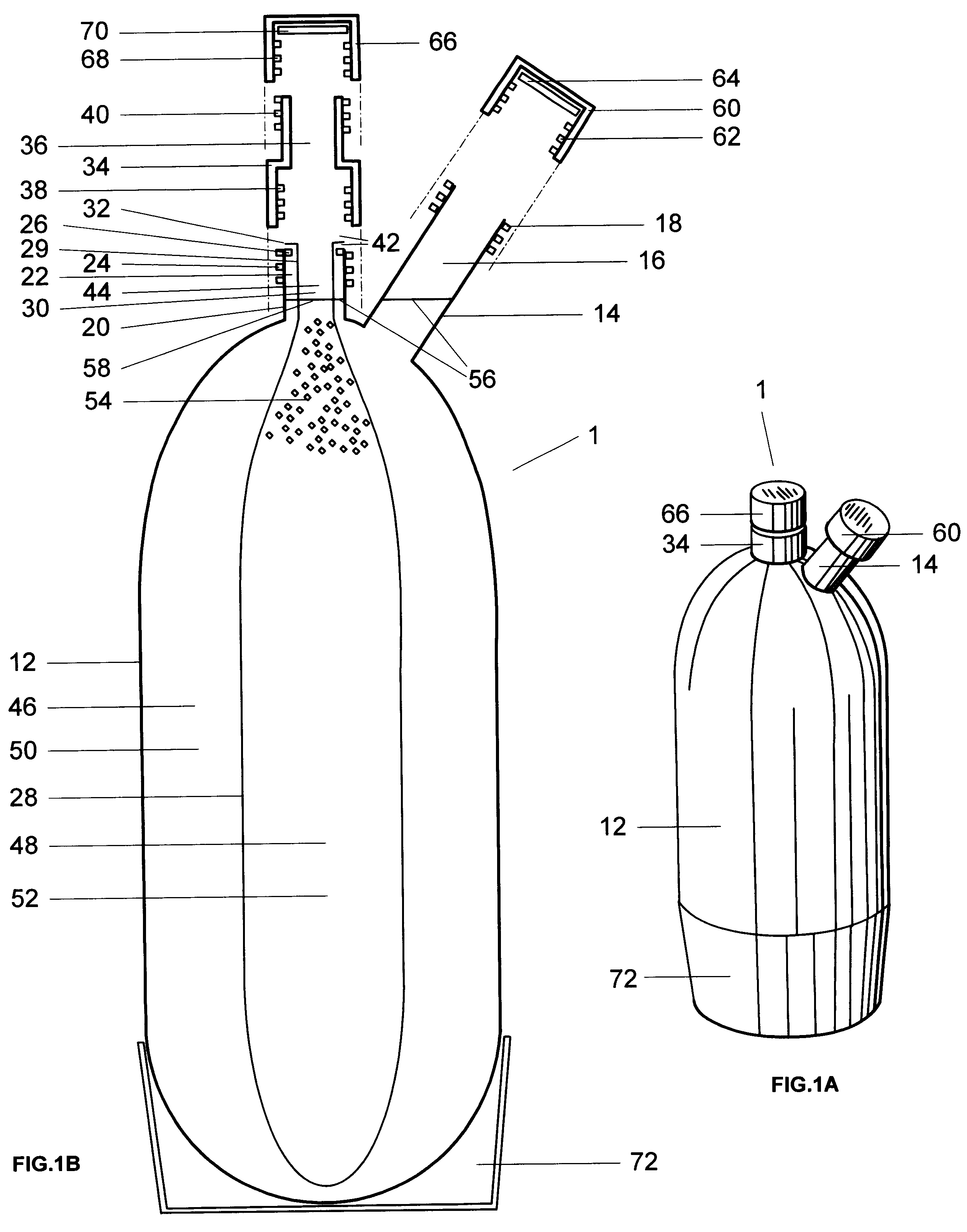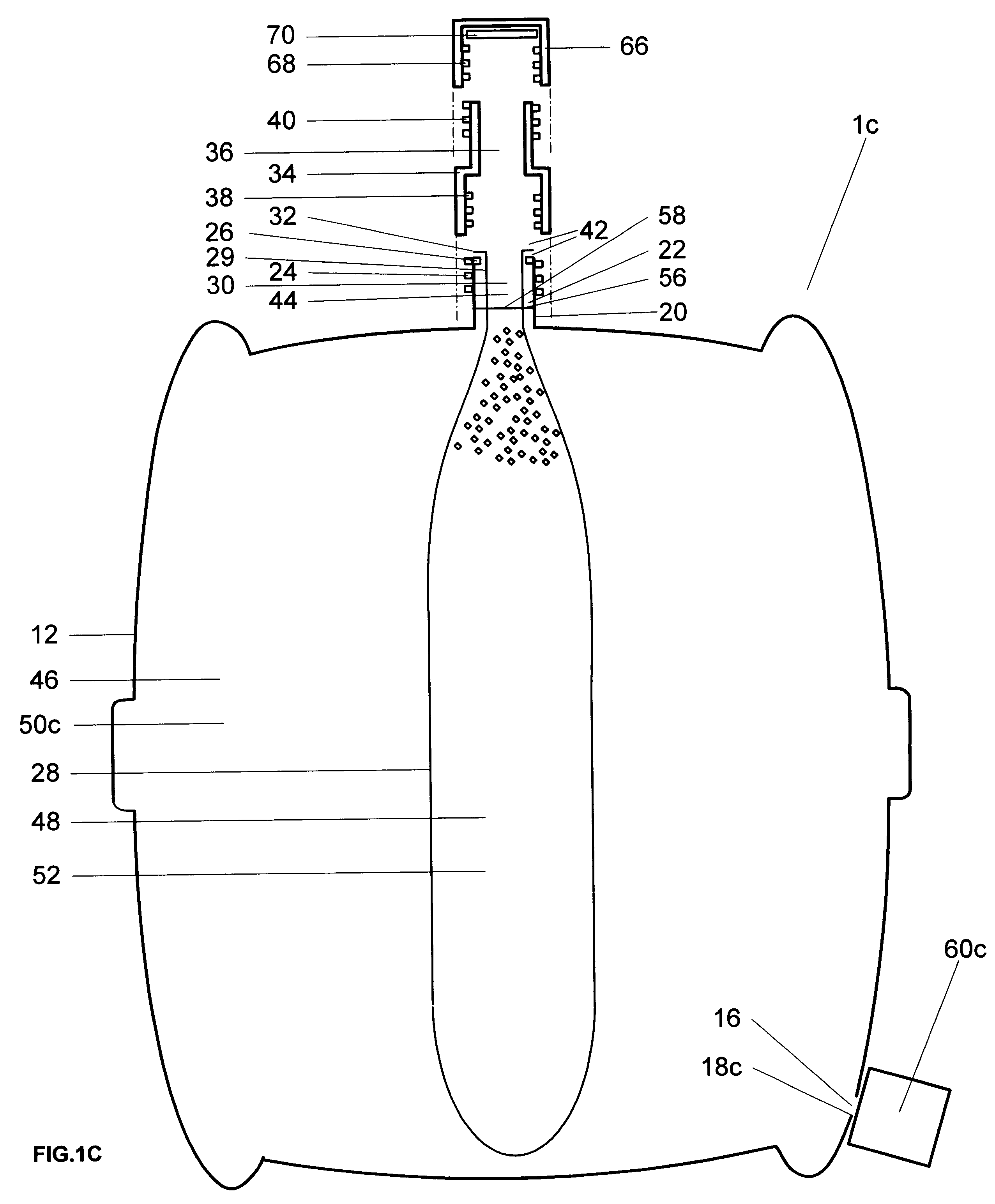Containers, when partially emptied of their contents, exhibit a wide range of undesirable characteristics.
Unless special and often expensive procedures are used,
atmosphere enters the container and pollutes it with undesirable elements such as
water vapor, air born contaminates, or unwanted
oxygen.
Containers that are emptied in
water baths, space, or in other material baths are damaged or difficult to pour in those environmental elements.
The contaminants can pre-maturely cure or damage the product or cause unwanted water condensation, as air sensitive paints and glues harden the
skin, fine wines and other preparations oxidize, dry wheat crackers get soggy, or
liquid fuel tanks gather water.
Another undesirable characteristic of a partially emptied container is the tendency for the usable material in the container to loose gas, off gassing to the
air space left in the container.
Off gassing results in premature curing or damaging of products.
It results in loss of material.
Off gassing can cause safety concerns as a mixture of fuel or other flammable vapor and
oxygen in a partially full
fuel tank can explode.
A half full container of a dusty material imposes increased
fire hazard if the dust air mixture is combustible, especially if that container is large such as in a storage
silo.
Containers that are partially filled with toxic or unpleasant material that evaporates emit more or unpleasant odors when opened then full containers do, polluting the environment and creating health risks.
One particularly poignant example of off gassing damage is that which occurs to partially consumed portions of effervescent beverages.
Unfortunately the carbonated beverage is stored under pressure in the
bottle and after the
bottle is opened, the best part of the gas is free is escape the beverage, and the drink goes flat.
Even if the cap is replaced, the gas is free to go into the air above the drink, and the bigger that space gets as the drink is "used up", the more gas can escape and the poorer the drink tastes.
A second opening of the container compounds the problem and accelerates the damage to the beverage.
Leaving a very small amount of beverage at the bottom of the container, will yield in a day, a drink that is almost devoid of
effervescence and foremost people, worthless.
That is, the water derived as the ice melts contaminates the drink and dilutes it.
Management of materials in containers that are only partially full creates a number of management difficulties.
For example a characteristic of a partially emptied container is that in many cases, it is more difficult to remove material from it.
A half empty tube of
toothpaste is harder to squeeze.
Rolling up the bottom of a
metal squeeze tube can cause the
metal to crack if rolling is done improperly.
As the mustard or glue in the
squeeze bottle is used up, it becomes more difficult to dispense, requiring
bottle inverting and shaking.
Delicate applications that require the material to be dispensed in a prescribed manner, such as decorative application by artists, precise glue or calk application, and cake
icing, become more difficult as the tube or bottle has less usable material in it.
Trying to squeeze the usable material in an upward direction, such as encountered when under a car and trying to make the squeeze can of
penetrating oil shoot in an upward direction, or putting material from a
squeeze bottle onto the underside of a horizontal surface such as a ceiling, is difficult.
Cylinders of expensive gasses can not be completely emptied in easy fashion.
Another undesirable characteristic of partially emptied containers is that the contents can move about or splash.
In vehicles, this leads to an uneven load that moves about disrupting the smoothness of the ride.
In other instances, sloshing causes the material in the container to froth up.
The vent often must be manually opened and closed, a labor consuming activity.
Air coming in the vent can pollute or damage the usable material in the container.
It is difficult to deliver a metered or specific amount of material from a container with out introducing air to the container.
Taking paint from a can and putting it into other containers for
brush dipping or rolling is a messy affair.
Pumping material requires apparatus of various degrees of complexity.
Pumping materials that are environmentally sensitive, in that they are volatile and pollute or in that they are damaged by contact with the
atmosphere requires expensive apparatus.
Because of the problems associated with partially filled containers, products are frequently shipped in smaller containers.
Also, more containers generally take more human and
machine effort to make.
The down side is that large containers can lead to increased amounts of spoilage of the unused contents of the containers.
Even in small containers, damaged unused material causes loss of energy and natural resources.
Utilization of extra energy and natural resources is detrimental to our environment.
These losses lead to financial loss.
Containers whose contents are packaged under pressure for spray tube delivery, have in the past, used
propellant gasses that may be damaging to the environment.
In general, it is a difficult problem to remove material from a container without allowing air to contact the remaining portions.
It is even more difficult to remove the material under these conditions in metered portions.
Preserving the unused portion of effervescent beverages has also over time proved to be a difficult problem to address economically.
These cumbersome to use as each time the container is opened, the entire container must be repressurized.
This prior art has not seen wide spread utilization because it is expensive to purchase and extremely cumbersome to use especially in the
home environment.
(1) to successfully provide an inexpensive and easy means to dispense usable material from containers with out the remaining unused portion of the usable material being exposed to
atmospheric air either during or after the dispensing operation. Air contains oxygen,
water vapor and contaminates which can damage usable materials.
(2) to successfully provide a means to dispense usable material from containers
underwater, in space or in other material baths from being exposed to those environments.
(3) as a result of the above, to greatly extend the life of materials stored in opened and partially used containers, in preventing premature curing, degradation, oxidation, hardening, or skinning, for atmospherically cured materials.
(4) to prove a means to prevent
moisture condensation in fuel tanks and other storage containers.
(5) to provide a means for limiting the absorption of
atmospheric water by materials exemplified by
dried food stuffs, crackers, dry cereal, snack chips,
dried fruit, candy, and organic materials.
(6) to successfully provide a means to limit
evaporation of usable materials stored in partially consumed containers, so as to prevent premature curing or aging damage.
(7) to successfully provide a means to limit
evaporation of usable materials stored in partially consumed containers.
(8) to provide a means for limiting freezer burn to usable materials stored in partially emptied containers that are frozen.
(9) to successfully provide a means to prevent dangerous air fuel mixtures from developing in partially empty fuel tanks and to prevent flammable air mixtures from developing in other partially emptied flammable volatile liquid containers.
(10) to provide a means to eliminate combustible dust air mixtures.
(11) to provide a means to reduce the amount of toxic or unpleasant smelling vapors that are emitted from containers by reducing the amount of
air space in the container and the surface area of the material exposed to the atmosphere, reducing environmental
pollution and health risks.
(12) to provide a means to reduce odors in
waste disposal and septic systems with holding tanks.
(13) to successfully provide an inexpensive and easy means to prevent effervescent beverages from going flat after their container has been opened and partially consumed.
(14) to provide a means to replenish
effervescence in valuable beverages that have already gone flat.
(15) to provide a means to conveniently cool drinks with ice, while the ice does not dilute the drink with water.
(16) to provide a means to make squeeze tubes and bottles deliver usable material as if they were full.
(17) to provide a means for easier and more controllable delivery of liquid or semi-liquid decorations and material administrations such as cake
icing, artist's preparations, and glue.
(18) to provide a means for squeeze tubes (such as those commonly used for
toothpaste) and squeeze bottles (such as those commonly used for glue or mustard) to deliver contents readily in an upward direction, even when the container is near empty of usable material.
(19) to provide a means for containers with simple taps, spigots, cocks, stopcocks, petcocks, or fittings to have the tap at any location in the container eliminating the need to have gravity bring the usable material to the bottom of the tank for exit at that low point.
(20) to provide a means to nearly empty a squeeze tube without
undo effort.
(21) to provide a means to almost completely empty valuable gas stored in cylinders.
(22) to provide a means to prevent fuel in tanks from sloshing (shifting) without baffles.
(23) to provide a means to reduce frothing of liquids in containers caused by sloshing.
(24) to reduce labor in opening and closing air vents on containers in some instances.
(25) to successfully provide a means for the dispensation of usable material in metered (measured) allotments without exposing the unused material to the atmosphere.
(26) to prove a means for extra stability by providing full containers which don't tip over so easily, even when the contents are partially consumed.
(27) to provide a means to achieve positive human psychological effects from using containers that seem full.
(28) to provide a means to take paint, and other materials out of a can, use it for
brush dipping or paint rolling, and to return the pain neatly to the can.
(29) to provide a simple inexpensive pump device, that also provides isolation of the usable material from the atmosphere, pollutants in the atmosphere, and water vapor in the atmosphere; extended life of the stored material by isolation from the atmosphere; reduced
pollution of the environment by toxic volatile material stored in the container of the pump device; and vapor free of storage of volatile flammable liquids.
(30) to provide a means to deliver material from pressurized containers generally at a uniform pressure, even as the usable material in the container is depleted.
(31) to provide means to conserve
natural resource and energy by making larger containers which have a greater usable material to container material ratio, and to make fewer containers.
(32) to provide means to serve
natural resource and energy through increased product life.
(33) to provide a means to deliver material form pressurized containers generally at a uniform pressure, even as the usable material in the container is depleted, with non-environmentally damaging
propellant gas.
For example, a one
liter plastic soda bottle will not attain an internal volume greater than one
liter regardless of the
internal pressure applied to it, within the pressure limits that deform the plastic, although squeezing the bottle could diminish the volume.
Air sensitive usable material can be damaged by
exposure to air in the atmosphere and thus the air sensitive usable material is also said to be "environmentally sensitive".
 Login to View More
Login to View More 


